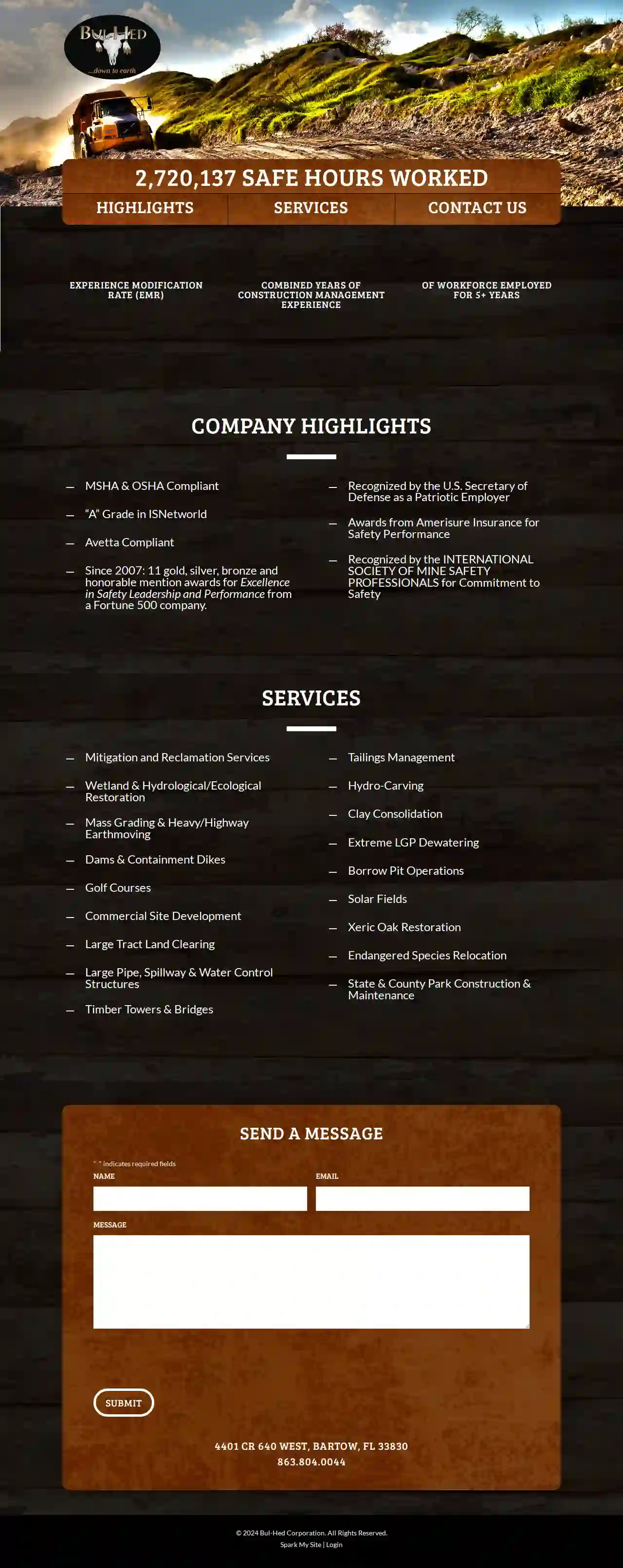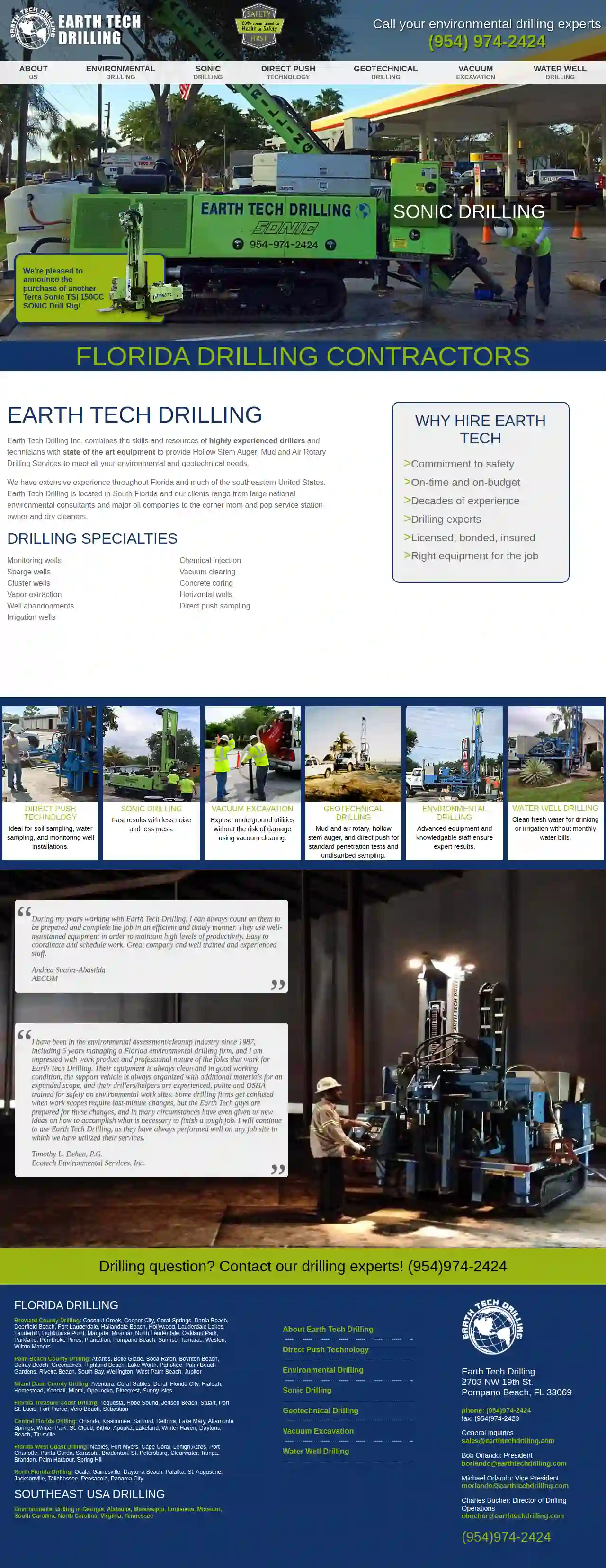Demolition Contractors South Pasadena
Find Demolition Contractors in South Pasadena
Receive 3 FREE Demolition Contractors quotes for your project today! Compare profiles, reviews, accreditations, portfolio, etc... and choose the best offer.

Bul Hed Corporation
511 reviews4401 CR 640 West, Bartow, 33830, US2,720,137 Safe Hours Worked Bul-Hed Corporation is a leading provider of environmental construction and reclamation services. We have a proven track record of success in delivering high-quality, safe, and environmentally responsible projects. Our team of experienced professionals is committed to exceeding our clients' expectations and delivering projects on time and within budget. Company Highlights MSHA & OSHA Compliant “A” Grade in ISNetworld Avetta Compliant Since 2007: 11 gold, silver, bronze and honorable mention awards for Excellence in Safety Leadership and Performance from a Fortune 500 company. Recognized by the U.S. Secretary of Defense as a Patriotic Employer Awards from Amerisure Insurance for Safety Performance Recognized by the INTERNATIONAL SOCIETY OF MINE SAFETY PROFESSIONALS for Commitment to Safety
- Services
- Why Us?
- Gallery
Get Quote
US Trenchless Inc.
4.971 reviews5716 Folsom Blvd., #290, Sacramento, 95819, USUS Trenchless: Your Trusted Partner for Trenchless Plumbing Solutions US Trenchless is a leading provider of trenchless plumbing services in Sacramento, CA. We specialize in a wide range of services, including sewer line repair, replacement, and inspection, as well as water line repair and replacement. Our team of experienced and certified technicians is committed to providing our clients with the highest quality service and workmanship. Why Choose US Trenchless? We understand that plumbing issues can be stressful and disruptive. That's why we strive to make the process as easy and hassle-free as possible for our clients. We offer: Free estimates 24/7 emergency service Competitive pricing A 100% satisfaction guarantee Our Services We offer a wide range of trenchless plumbing services to meet the needs of our residential and commercial clients. Our services include: Sewer line repair and replacement Water line repair and replacement Pipe bursting Horizontal directional drilling Sewer line inspection Hydro jetting Water heater installation and repair Water softener installation Water filtration system installation Our Team Our team of experienced and certified technicians is dedicated to providing our clients with the highest quality service and workmanship. We are committed to using the latest technology and techniques to ensure that our work is done right the first time. Contact Us Today If you are experiencing a plumbing issue, don't hesitate to contact US Trenchless. We are available 24/7 to provide you with the help you need. Call us today for a free estimate.
- Services
- Why Us?
- Our Team
- Testimonials
- Gallery
Get Quote
Florida RCC
52 reviews1205 US Highway 17 92 South, Davenport, 33837, USBetter Than Asphalt, Stronger Than Concrete! A Trusted Service You Can Rely On! Read More Tough, Fast, Economical These qualities have taken RCC from specialized applications to mainstream pavement. Today, RCC is used for any type of industrial or heavy duty pavement. The reason is simple. RCC has the strength and performance of conventional concrete with the economy and simplicity of asphalt. Coupled with long service life and minimal maintenance, RCC’s low initial cost adds up to economy and value. A Different Type of Concrete No Rutting, No Pot Holes Unique Mix, Unique Construction Economy, Performance and Versatility
- Services
- Why Us?
- Gallery
Get Quote
JPS General Construction
53 reviews123 Main Street, Anytown, 12345, USAbout JPS General Construction JPS General Construction is a family-owned and operated business with over 20 years of experience in the construction industry. We are committed to providing our clients with high-quality workmanship, exceptional customer service, and competitive pricing. We specialize in a wide range of construction services, including: Residential construction Commercial construction Remodeling Additions Roofing Siding Windows and doors Decks and patios Concrete work And more! We are fully licensed, insured, and bonded, and we are committed to providing our clients with peace of mind. We work closely with our clients to ensure that their projects are completed on time and within budget. We are also dedicated to providing our clients with a positive and stress-free construction experience. If you are looking for a reliable and experienced construction company, look no further than JPS General Construction. We are committed to providing our clients with the highest quality construction services available.
- Services
- Why Us?
Get Quote
A.J.O. Group
4.928 reviews73 Sumner St, Unit 205, San Francisco, 94103, USGeneral Contracting & Structural Engineering Specializing in Structural & Seismic Upgrades Construction only, or complete Design-Build! Established in 2007, A.J.O. Group provides comprehensive design-build services for commercial and residential structural & seismic upgrades. Our experience in both Structural Engineering & General Contracting fields allows us to employ an optimal approach to all phases. We have the skilled team and tools to deliver a full Design-Permitting-Construction package, start to finish. 2007 Year Established 375+ Engineering Projects 115+ Construction Projects 140+ Soft Story Retrofits
- Services
- Why Us?
- Our Team
- Gallery
Get Quote
Earth Tech Drilling
4.610 reviews2703 NW 19th St., Pompano Beach, 33069, USEarth Tech Drilling Earth Tech Drilling Inc. combines the skills and resources of highly experienced drillers and technicians with state of the art equipment to provide Hollow Stem Auger, Mud and Air Rotary Drilling Services to meet all your environmental and geotechnical needs. Experience We have extensive experience throughout Florida and much of the southeastern United States. Earth Tech Drilling is located in South Florida and our clients range from large national environmental consultants and major oil companies to the corner mom and pop service station owner and dry cleaners. Why Hire Earth Tech Commitment to safety On-time and on-budget Decades of experience Drilling experts Licensed, bonded, insured Right equipment for the job
- Services
- Why Us?
- Our Team
- Testimonials
- Gallery
Get Quote
Eagle Asphalt - Asphalt & Paving Contractor
4.920 reviews4721 W. Jennifer Ave., #14, 4721 W. Jennifer Ave. #14, Fresno, 93722, USEagle Asphalt CA Eagle Asphalt proudly offers a wide range of services, we are your one-stop pavement and asphalt solution! Whether it be an asphalt overlay, new asphalt construction, or asphalt repair, Eagle Asphalt in Fresno, California has the experience and expertise to see the job through from start to finish. Give us a call… today! Eagle Asphalt in Fresno, CA is Locally Owned, Licensed & Insured. Serving Central Valley.
- Services
- Why Us?
- Our Team
- Testimonials
- Gallery
Get Quote
Haines & Kibblehouse, Inc.
4.616 reviewsP.O. Box 196, 2052 Lucon Road, Skippack, 19474, USH&K Group, Inc.: Building a Better Future Since 1968 H&K Group, Inc. is a family of companies dedicated to providing exceptional products and services in the heavy civil contracting and construction materials industries. We are committed to delivering strength, experience, and value to our customers in the Mid-Atlantic Region. Our diverse portfolio of companies allows us to operate individually or as a collective team, ensuring we can meet the unique needs of each project. We are constantly innovating and adapting to meet the challenges of the ever-changing construction landscape. At H&K Group, Inc., we believe in building a better future for our customers, our employees, and our communities. We are proud of our legacy and excited about the future.
- Services
- Why Us?
- Gallery
Get Quote
A-ROD Construction
54 reviewsSuite 100, 6010 McPherson Rd., Laredo, 78041, USA-ROD Construction Inc. A-ROD Construction Inc. is proudly owned by South Texan and Native Laredoan, Armando “Mando” Rodriguez. At A-ROD Construction, we take great pride in our work and value our customers as our primary asset. The company was established in the year 2000 as a fully-bonded heavy equipment dirtwork and asphalt operator. We have been proudly serving Laredo and surrounding areas in South Texas with over 20 years of experience. We specialize in site work, excavating, and asphalt paving. Our other services include underground utilities, subdivisions, mass earth work, warehouse pad sites, concrete work, and much more. Contact us for all of your Commercial, Industrial, or Residential construction needs. As of 2019, we have been proud to announce our expansion to San Antonio, Texas and surrounding areas. Today, A-ROD Construction has continued to grow & expand rapidly, while earning a trusted reputation due to the satisfaction of our valued customers. Commercial, Residential, and Industrial Projects Our scope of work includes Commercial, Residential and Industrial projects. If you are interested in our wide range of services and the value that we can bring to your operation, let’s discuss your project today! Contact A-ROD Construction now.
- Services
- Why Us?
- Gallery
Get Quote
A.P. Thomas Construction, Inc.
52 reviews2330 Butano Drive, Sacramento, 95825, USIt’s a Great Day to Build! With A.P. Thomas Construction, Inc., an award-winning company based in the Sacramento area, you’ll recognize a company that rivals larger firms in capabilities and value, yet gives personal attention and commitment to you and your investment. For more than two decades, we’ve delivered innovation, diversity and quality to commercial projects throughout Northern California.
- Services
- Why Us?
- Gallery
Get Quote
Over 22,076+ Excavation Contractors onboarded
Our excavation companies operate in South Pasadena & surrounding areas!
ExcavationHQ has curated and vetted Top Excavation Companies in South Pasadena. Find a trustworthy pro today.
Frequently Asked Questions About Demolition Contractors
- Implosion: Using explosives to collapse a structure inwards rapidly. Suitable for large buildings in open areas.
- Wrecking Ball: Swinging a large steel ball to impact and break down the structure. Effective for bringing down walls and other solid elements.
- High-Reach Demolition: Utilizing specialized excavators with extended arms and demolition attachments for dismantling tall structures piece by piece.
- Selective Demolition: Removing specific parts of a building while preserving other sections. Often used in renovation projects.
- Deconstruction: Carefully dismantling a building to salvage reusable materials, reducing waste and environmental impact.
- General Liability Insurance: Covers bodily injury or property damage to third parties caused by the contractor's negligence.
- Workers' Compensation Insurance: Provides benefits to workers injured on the job.
- Pollution Liability Insurance: Covers costs associated with environmental contamination caused by demolition activities.
- Professional Liability Insurance: Protects against claims of negligence or errors in professional services, such as demolition planning or consulting.
- Size and Type of Structure: The method should be suitable for the structure's size, height, and construction materials.
- Site Location and Accessibility: The method should be feasible given the site's location, surrounding buildings, and access constraints.
- Environmental Considerations: Prioritize methods that minimize environmental impact, such as deconstruction or selective demolition if feasible.
- Budget: Different demolition methods have varying costs, so choose one that fits your budget.
- Safety: Prioritize methods that ensure worker safety and minimize risks to surrounding areas.
- Experience: Look for companies with a proven track record and years of experience in the demolition industry.
- Licensing and Insurance: Ensure the contractor is properly licensed to operate in your area and carries adequate insurance to protect you from liability.
- Safety Record: Inquire about their safety protocols and accident history. A reputable contractor prioritizes safety.
- References and Reviews: Ask for references from past clients and check online reviews to gauge their reputation and customer satisfaction.
- Professionalism: Choose a company that communicates clearly, provides detailed estimates, and has a courteous and responsive team.
What are the different types of demolition?
What is the importance of insurance in demolition projects?
How do I choose the right demolition method for my project?
How do I find a reputable demolition contractor?
What are the different types of demolition?
- Implosion: Using explosives to collapse a structure inwards rapidly. Suitable for large buildings in open areas.
- Wrecking Ball: Swinging a large steel ball to impact and break down the structure. Effective for bringing down walls and other solid elements.
- High-Reach Demolition: Utilizing specialized excavators with extended arms and demolition attachments for dismantling tall structures piece by piece.
- Selective Demolition: Removing specific parts of a building while preserving other sections. Often used in renovation projects.
- Deconstruction: Carefully dismantling a building to salvage reusable materials, reducing waste and environmental impact.
What is the importance of insurance in demolition projects?
- General Liability Insurance: Covers bodily injury or property damage to third parties caused by the contractor's negligence.
- Workers' Compensation Insurance: Provides benefits to workers injured on the job.
- Pollution Liability Insurance: Covers costs associated with environmental contamination caused by demolition activities.
- Professional Liability Insurance: Protects against claims of negligence or errors in professional services, such as demolition planning or consulting.
How do I choose the right demolition method for my project?
- Size and Type of Structure: The method should be suitable for the structure's size, height, and construction materials.
- Site Location and Accessibility: The method should be feasible given the site's location, surrounding buildings, and access constraints.
- Environmental Considerations: Prioritize methods that minimize environmental impact, such as deconstruction or selective demolition if feasible.
- Budget: Different demolition methods have varying costs, so choose one that fits your budget.
- Safety: Prioritize methods that ensure worker safety and minimize risks to surrounding areas.
How do I find a reputable demolition contractor?
- Experience: Look for companies with a proven track record and years of experience in the demolition industry.
- Licensing and Insurance: Ensure the contractor is properly licensed to operate in your area and carries adequate insurance to protect you from liability.
- Safety Record: Inquire about their safety protocols and accident history. A reputable contractor prioritizes safety.
- References and Reviews: Ask for references from past clients and check online reviews to gauge their reputation and customer satisfaction.
- Professionalism: Choose a company that communicates clearly, provides detailed estimates, and has a courteous and responsive team.